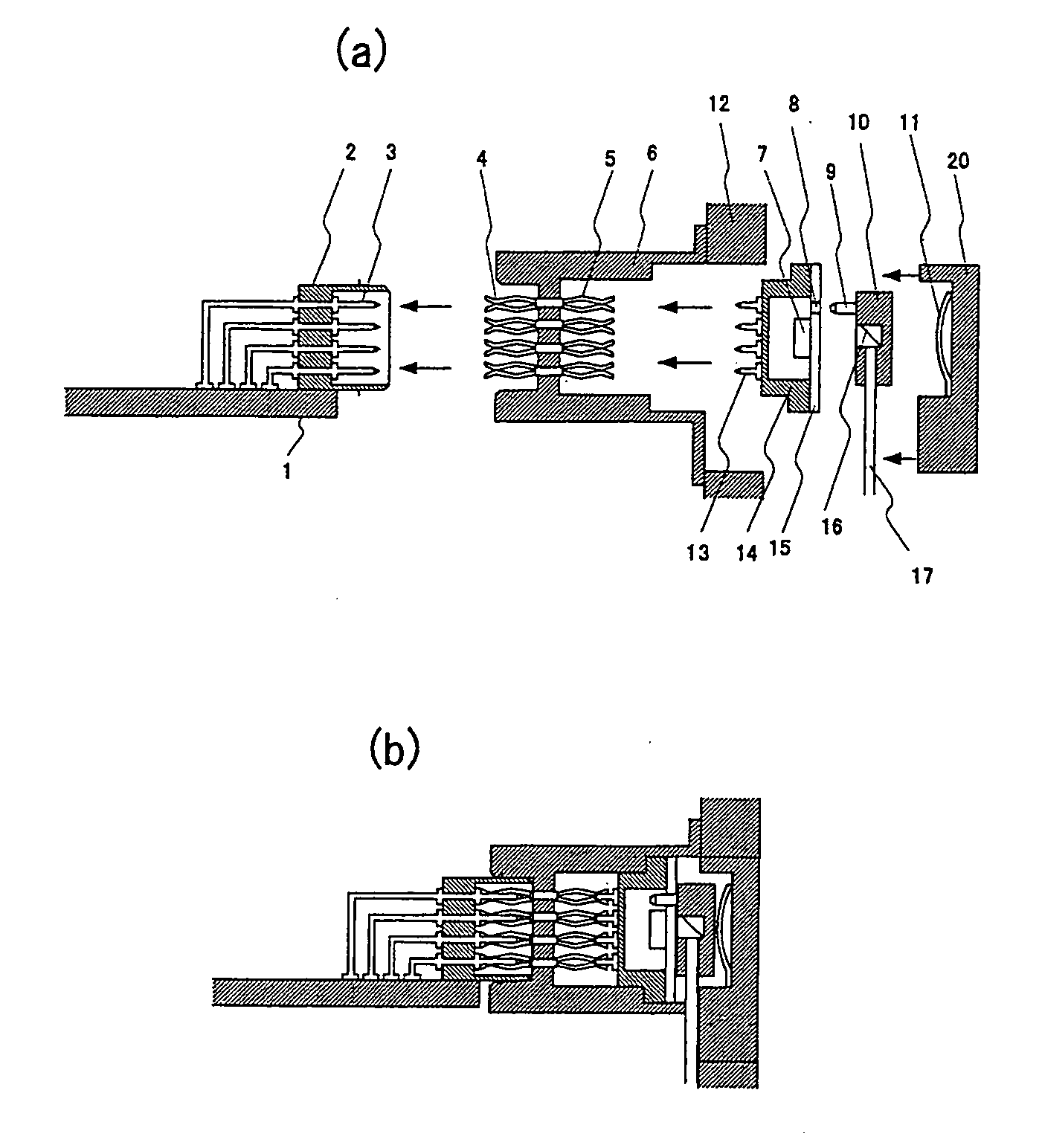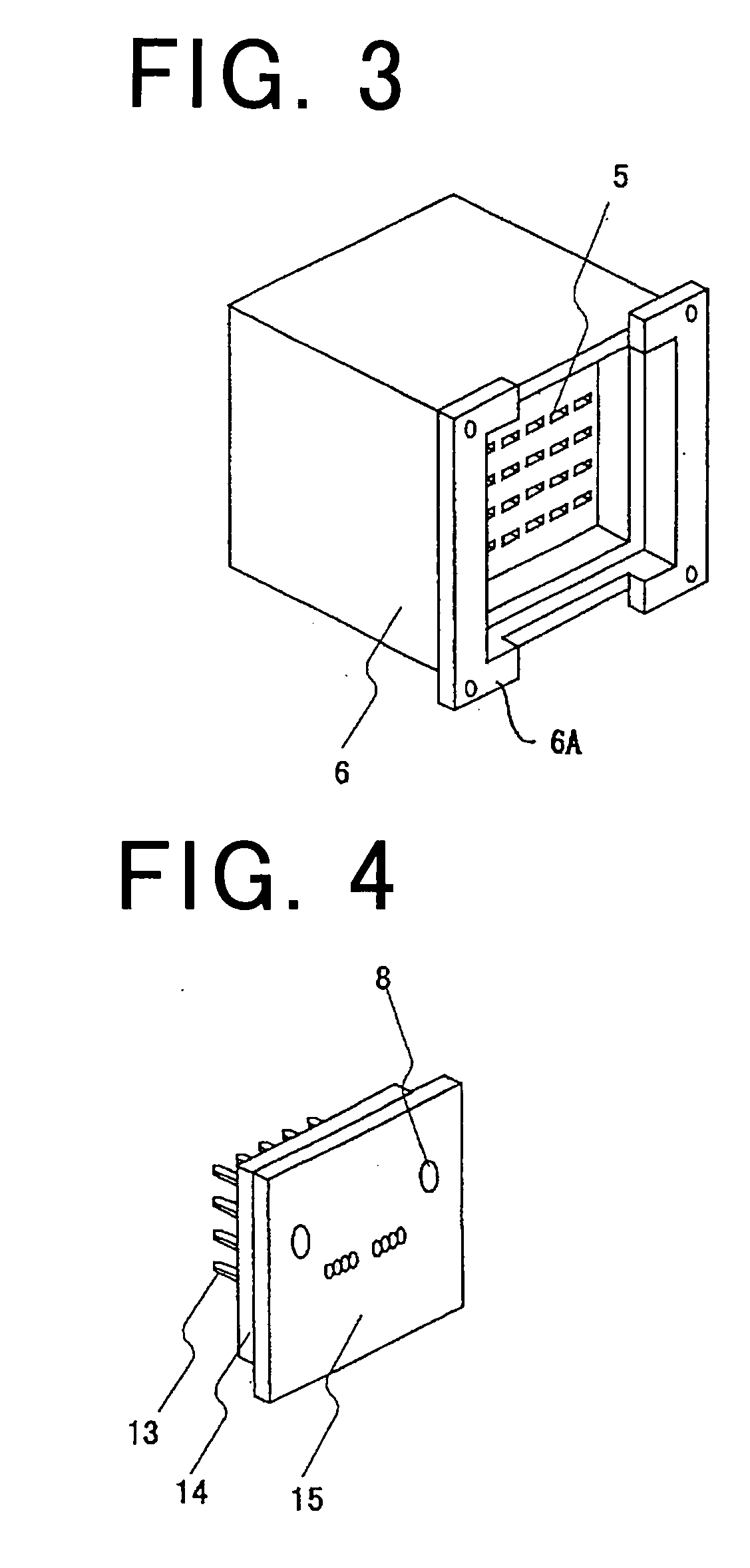Optical backplane connector, photoelectric conversion module and optical backplane
- Summary
- Abstract
- Description
- Claims
- Application Information
AI Technical Summary
Benefits of technology
Problems solved by technology
Method used
Image
Examples
first embodiment
[0068]FIGS. 1(a), (b) show the optical backplane connector and the optical backplane according to a first embodiment of the invention. FIG. 1(a) is a sectional view showing the connecting operation between the board and the optical backplane and the assembly and mounting operation of the optical backplane connector, and FIG. 1(b) a sectional view showing the connected state.
[0069]FIG. 2 is a perspective view showing the board-side electric connector, FIG. 3 a perspective view of the optical backplane connector taken from the photoelectric conversion module side, FIG. 4 a perspective view of the photoelectric conversion module taken from the backplane side, FIG. 5 a perspective view showing an optical connector 10, and FIG. 6 a perspective view showing a part of the optical backplane.
[0070]FIG. 7 is an assembly diagram of the board-side electric connector, the optical backplane connector and the photoelectric conversion module, and FIG. 8 an assembly diagram of the optical backplane ...
second embodiment
[0081]FIG. 9 shows the optical backplane connector and the optical backplane according to a second embodiment of the invention. In FIG. 9, the same component members as those of FIG. 1 are designated by the same reference numerals, respectively, and not explained further. The photoelectric conversion module 14 accommodates therein a plurality of photoelectric conversion elements 7 which are coupled to the optical transmission paths 17 extending in different directions. The fitting holes 8 of the photoelectric conversion module 6 are formed between the photoelectric conversion elements 7, and the guide pins 9 of the optical connector 10 are inserted in the fitting holes 8. According to this embodiment, the switch board mounted in the neighborhood of the center of the rack can be connected with the signal input / output board mounted on each of the right and left sides in such a manner that the surrounding connecting wires of the optical transmission paths on the optical backplane can b...
third embodiment
[0082]FIG. 10 shows an optical backplane connector and an optical backplane according to a third embodiment of the invention. FIG. 10(a) is an exploded sectional view showing this configuration as viewed from the upper surface of the board, and FIG. 10(b) a sectional view taken from the upper surface of the board inserted into the backplane. Also, FIG. 11 is a diagram showing the method of fixing the optical connector and the lid. In FIGS. 10(a), (b), the same component members as those in FIG. 1 are designated by the same reference numerals, respectively, and not explained further.
[0083]According to this embodiment, a lid 20 is arranged on the through-hole in which the optical backplane of the backplane is passed. By opening the lid 20 and pulling out the guide pins 9 of the optical connector 10 from the fitting holes 8 of the photoelectric conversion module 14, the photoelectric conversion module can be taken out to rearward of the optical backplane. With this structure, the photo...
PUM
 Login to View More
Login to View More Abstract
Description
Claims
Application Information
 Login to View More
Login to View More - R&D
- Intellectual Property
- Life Sciences
- Materials
- Tech Scout
- Unparalleled Data Quality
- Higher Quality Content
- 60% Fewer Hallucinations
Browse by: Latest US Patents, China's latest patents, Technical Efficacy Thesaurus, Application Domain, Technology Topic, Popular Technical Reports.
© 2025 PatSnap. All rights reserved.Legal|Privacy policy|Modern Slavery Act Transparency Statement|Sitemap|About US| Contact US: help@patsnap.com



